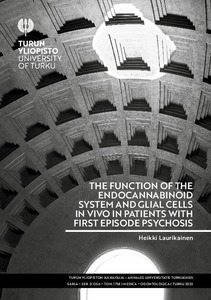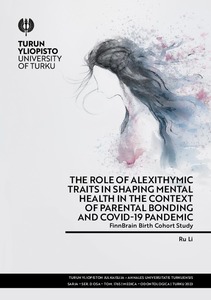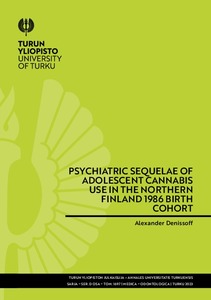Hae
Aineistot 11-20 / 22
Associations of maternal prenatal hair cortisol with maternal and child distress symptoms - The FinnBrain birth cohort study
(Turun yliopisto, 2024-11-29)
Maternal prenatal psychological distress (PD) can steer offspring development through adaptations in fetal programming. Maternal systemic cortisol levels are hypothesized to be a major mechanism in transmitting distress ...
The function of the endocannabinoid system and glial cells in vivo in patients with first episode psychosis
(Turun yliopisto, 2023-12-01)
Psychoses are relatively common and often severely debilitating mental disorders with a multifactorial etiological background involving both psychosocial and biological factors. Previously reported associations between the ...
The role of alexithymic traits in shaping mental health in the context of parental bonding and COVID-19 pandemic: FinnBrain birth cohort study
(Turun yliopisto, 2024-01-12)
Alexithymia, a personality trait characterized by difficulties in identifying (DIF) and describing feelings (DDF), a pragmatic and externally oriented thinking style (EOT), and a scarcity of fantasy and imagination, was ...
Maternal prenatal stress, infant microbiota, brain, and behavioral development : The FinnBrain Birth Cohort Study
(Turun yliopisto, 2021-02-12)
The gut microbiota and its manipulation have been shown to affect behavior and neurodevelopment in rodents. Likewise, maternal prenatal stress is known to influence offspring health and development as well as gut microbiota ...
Is substance use of any substance? Study on substance use and mental health on Russian, Somali and Kurdish origin populations in Finland
(Turun yliopisto, 2022-02-04)
To date, our knowledge on substance use in migrated populations in their host countries is scarce. In addition, associations between discrimination and substance use have been rarely investigated in the European context.
The ...
Prenatal and perinatal epidemiology of anxiety disorders
(Turun yliopisto, 2023-05-12)
Anxiety disorders are the most common psychiatric disorders among children and adolescents. The aetiology of anxiety disorders is known to be multi-factorial and to include genetic and environmental factors. Prenatal and ...
Brain white matter development, associations to maternal perinatal psychological distress and emotional attention at the age of 5 years
(Turun yliopisto, 2024-03-28)
Development of the brain white matter (WM) is highly plastic, and myelination continues from the second trimester into early adulthood which predisposes the brain to effects of both adverse and supporting factors during ...
Psychiatric sequelae of adolescent cannabis use in the Northern Finland 1986 Birth Cohort
(Turun yliopisto, 2023-04-14)
Adolescence is a time of significant brain development, and this maturation process is thought to represent a time of heightened vulnerability to the adverse effects of environmental risk factors such as cannabis. While ...
Brain morphology in early psychosis – A magnetic resonance imaging and clinical study: Associations with childhood adversities, glucose metabolism, and antipsychotic drug use
(Turun yliopisto, 2025-05-30)
The etiology of psychotic disorders is multifactorial and developmental, influenced significantly by genetic factors and various environmental factors, such as childhood adversity. Psychotic disorders, such as schizophrenia, ...
Child brain development: exploring prenatal impacts and emotional perception through advanced neuroimaging – Findings from the FinnBrain Birth Cohort MRI Study
(Turun yliopisto, 2024-09-13)
The amygdala, a key player in emotional processing, undergoes rapid growth and development prenatally and in infancy. Environmental factors, such as prenatal maternal depressive symptoms, can alter the structure of the ...








